Developing a modified Pulsincap system
Pharmaceutical Technology Europe
Chronotherapeutic drug delivery systems (CRDDS) have been recognized as potentially beneficial to the chronotherapy (timeoptimized therapy) of widespread chronic diseases that display time-dependent symptoms.
Chronotherapeutic drug delivery systems (CRDDS) have been recognized as potentially beneficial to the chronotherapy (timeoptimized therapy) of widespread chronic diseases that display time-dependent symptoms, such as ulcers, asthma, cardiovascular diseases and arthritis. CRDDS control drug release according to circadian rhythms and the timing of symptoms.1 A number of CRDDS have been developed to synchronize medication with the intrinsic biorhythm of the disease; with conventional and modifiedrelease formulations being administered at different times of the day in accordance with the circadian onset of the disease.2

Creativ Studio Heinemann/Getty Images
People with rheumatoid arthritis (RA), usually experience peak pain in the morning, which decreases throughout the day. In this scenario, an evening once-a-day nonsteroidal anti-inflammatory drug (NSAID) schedule is recommended. If pain is worse during early afternoon or at night, however, a morning or an evening onceaday NSAID schedule may be recommended. The exact dose depends on the severity of the patient's pain and their individual physiology.3 Most newly developed antiRA agents are now available as oncedaily dosage forms; the absorption kinetics of conventional dosage forms are inadequate in the morning, which is when the need of patient is greatest, and drug levels of once-a-day formulations that have nighttime dosing indication tend to fall off towards the end of the 24h dosing interval, resulting in reduced protection against the pain when the need is more.
Diclofenac sodium (DS) is a potent NSAID frequently used to treat RA; however, oral administration of DS as a conventional formulation generally fails to achieve the desired clinical effect because it elicits patient incompliance — many fail to take the dosage early enough in the morning to coordinate with the rhythm of RA. Therefore, the development of oral controlledrelease formulations of this drug is highly desirable.
The Pulsincap system, developed and registered by R.P. Scherer International Corp. (MI, USA), is a special dosage form comprising a waterinsoluble capsule body enclosing a drug reservoir. The body is closed at the open end with a swellable hydrogel plug, which consists of insoluble, but permeable and swellable polymers (e.g., polymethacrylates), erodible compressed polymers (e.g., hydroxypropylmethyl cellulose, polyvinyl alcohol, polyvinyl acetate, polyethylene oxide), congealed melted polymers (e.g., saturated polyglycolated glycerides, glyceryl monooleate) and/or enzymatically controlled erodible polymers (e.g., pectin). When this capsule comes in to contact with the dissolution fluid, it swells and, after a lag time, the plug pushes itself outside the capsule and rapidly releases the drug. The length of the plug and its position of insertion into the capsule controls the lag time.4,5
In our study, a modified Pulsincap device containing DS was developed to target drug release in the colon. This is a sitespecific and timedependent formulation; by administering the formulation at 10.00 pm, symptoms that are experienced early in the morning are avoided. This therapeutic effect is prolonged by continuously releasing the medication over an extended period of time after administering a single dose. The study objective was to explore the time-and pHdependent controlled drug delivery of DS using the pulsincap system.
Material and methods
Materials
DS was obtained as gift sample from Welable Parma Ltd (India). pHsensitive methacrylic acid copolymers (Acrycoat L 100 and S 100) were supplied as gifts by Corel Pharma Ltd (India). Hydroxypropylmethyl celluloseK4M (HPMC) and hydroxypropyl cellulose (HPCH) were obtained as a gift from Colorcon (India). Sodium carboxymethyl cellulose (NaCMC), cellulose acetate phthalate (CAP), guar gum (GG) and sodium alginate (NaAlg) were purchased from S.D. Fine Chem. Ltd (India). All other chemicals used were of analytical grade.
Methods
Step 1: preformulation study for polymer selection
According to the literature reviewed, the pH in the proximal colon ranges from 6.6 to 7.0 (~6.8).6 A combination of acrycoat L 100 and S 100 was therefore designed to maintain the optimum pH. Accordingly, acrycoat L 100 (soluble in pH 6 and above) and acrycoat S 100 (soluble in pH 7 and above) were mixed in different ratios (1:1, 1:1.5, 1:2 and 1:3) and the final mixtures underwent solubility studies at pH 6.8. Based on the solubility parameters, we ascertained that acrycoat L 100 and acrycoat S 100 at a ratio of 1:2 was highly soluble in pH 6.8. This combination was therefore selected for the preparation of microcapsules.
Step 2: microcapsule preparation
The acrycoat microcapsules containing DS were prepared using emulsification-solvent evaporation in an oily phase. Accurately weighed acrycoat L 100 and acrycoat S 100 in the ratio of 1:2 were dissolved in 10 mL of acetone to form a homogenous polymer solution. Drug was separately suspended in the polymer solution, which was maintained in a continuous phase consisting of 70 mL of liquid paraffin, 1% (w/w) of span 80 and 0.01% (v/v) simethicon (as antifoaming agent) and was stirred constantly at 1000 rpm using a variable speed propeller stirrer to form a uniform emulsion. Approximately 5–10 mL of acetone was added to the external continuous phase to produce a stable oil/oil emulsion and then stirring was continued (3–4 h) until residual acetone had evaporated. The microcapsules formed were separated by filtration, washed three to four times with nhexane to remove adhering liquid paraffin, and dried for 48 h in a vacuum desiccator.
Four batches were prepared by varying the drug to polymer ratio (D:P=1:0.5, 1:1, 1:1.5 and 1:2 (w/w) named DM 1 to 4, respectively) and evaluated for their flowability, particle size, drug content, surface morphology, compatibility and in vitro release profile.
Step 3: capsule preparation
The body and the cap of the hard gelatin capsules were separated. The body portion of the capsules was placed on a wire mesh into a desiccator, which was then exposed to formaldehyde vapours for 6 h at room temperature and dried at 50 °C for 48 h in a hot air oven. The treated capsule bodies were capped with untreated caps and stored at ambient conditions in a sealed glass container.7
Step 4: capsule filling
The microcapsule formulation that had shown good drug content and release characteristics was placed into the capsule manually. Microcapsules (D:P=1:1.5) equivalent to 100 mg of DS were incorporated into treated bodies of empty capsule shells and plugged with different amounts (10, 15 and 20%) of hydrogel polymers; that is, NaCMC, GG, HPMC, HPCH and NaAlg.
Step 5: sealing and coating of capsules
The joint of the treated body and cap of the capsule was sealed with a small amount of the 5% w/v ethyl cellulose ethanolic solution, and the filled and sealed capsules were then coated with CAP to ensure that drug release occurred in the colon rather than in the stomach. The various parameters of coating conditions were standardized, such as dipping time (5 s), coating solution concentration, temperature (25±10 °C) and drying time (5 min) at 500 °C. Coating was repeated until a 6–8% increase in weight was obtained. The percentage weight gain of the capsules before and after coating was determined using Equation 1.

Where Wt is the weight of the capsules after coating, Wo is the initial weight of capsules. The capsules were dried in an oven at 50 °C for 12 h.
Evaluation of prepared microcapsules
Determination of drug entrapment efficiency
The efficiency of drug entrapment8 for each batch was calculated in terms of percentage drug entrapment (PDE) using the formula in Equation 2.

Theoretical drug loading was calculated on the assumption that all of the drug in the polymer solution used was entrapped in the microcapsules and that none was lost during the preparation of the microcapsules.
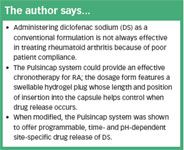
The author says...
Practical drug loading was determined by taking accurately weighed microcapsules equivalent to 100 mg of drug and crushed using a glass pestle and mortar. Methanol was added in small quantities to the mortar and transferred to a 50mL volumetric flask. The mortar was washed with methanol to remove all traces of drug and transferred to the flask. The volume was then increased to 50 mL with the same solvent. The flasks were kept on a sonicator for 5 min. The solution was then filtered using a Whatman filter paper and a suitable dilution was made. Absorbance was read at 281 nm against methanol as a blank. The PDEs of DM1 to DM4 are reported in Table 1.
Micromeritic properties of prepared microcapsules
The micromeritic properties of the microcapsules9 were determined by the angle of repose (using the fixedbase funnel method), bulk density, tapped density and Carr's index. Bulk and tapped densities were measured in 10 mL of a graduated glass cylinder. The sample contained in the cylinder was tapped mechanically by a constantvelocity rotating cam. The results are shown in Table 1.

Table 1: Physical characteristics of DS microcapsules.
Particle size and morphology study of microcapsules
The average particle size and morphology of the drugloaded microcapsules10 (n=100) of batches DM1 to DM4 were assessed by using a digital optical microscope (Labomed CX RIII, Ambala, India) and SEM microscopy, respectively. The microcapsules' morphology was characterized by their sphericity and clumping. The results are reported in Table 1 and Figure 1.
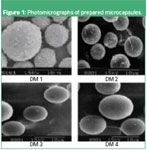
Figure 1
In vitro release profile of microcapsules
The in vitro dissolution profile of each formulation11 was determined using the USP Dissolution Apparatus 1 Basket method (900 mL of pH 6.8phosphate buffer, 100 rpm, 37±0.5 °C). Microcapsules equivalent to 100 mg of drug were loaded into the basket (covered with Teflon cloth [porous polytetrafluoroethylene (PTFE) cloth]) of the dissolution apparatus. Ten millilitres of the sample were withdrawn from the dissolution media at suitable time intervals and the same amount was replaced with fresh buffer. Samples were filtered though a Whatman filter paper and suitable dilutions were made when required. The absorbance of the samples was determined at the wavelength of 276 nm using UV–Vis spectrophotometer, against pH 6.8 phosphate buffer as a blank. The amount of drug present in the filtrate was then determined from the calibration curve, and cumulative percent of drug release was calculated.
Compatibility study
A compatibility study was employed to assess the physicochemical compatibility between drug and the various excipients used in the formulation.12 FTIR spectrums of drug, acrycoat S 100 and L 100polymer mixture, drug–polymer physical mixture and formulation were taken and are reported in Figure 2.
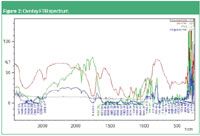
Figure 2
Evaluation of designed pulsatile capsule
The polymer used in the Pulsincap dosage form should be able to swell to its maximum and eject from the capsule body in intestinal fluid. The body portion of the capsules was subjected to disintegration studies at room temperature in a buffer solution of pH 1.2, 7.4 and 6.8.
Ten capsules were selected randomly from each batch and weighed individually for weight variation.
In vitro release profile of the pulsatile capsule
Dissolution studies were performed using the USP Dissolution Apparatus 2 Paddle Method (900 mL of dissolution medium, 100 rpm, 37±0.5 °C). Capsules were tied to the paddle with a cotton thread in each dissolution vessel to prevent floating.13
To simulate the pH changes along the gastrointestinal tract, three dissolution media with pH 1.2 (simulated gastric fluid (SGF) prepared by dissolving 2 g of NaCl and 3.2 g pepsin in 7 mL of HCl, and then adding deionized water (DW) to 1000 mL, used for 2 h), 7.4 (simulated intestinal fluid (SIF) prepared by dissolving 6.8 g of monobasic potassium phosphate in 250 mL of DW, then adding 190 mL of 0.2 N NaOH, 400 mL of DW and 10 g of pancreatin, and finally adding 0.2 N NaOH to adjust the pH to 7.4, and then diluting with DW to 1000 mL, used for 3 h) and 6.8 (simulated colonic fluid (SCF) prepared by adding 170 mL 1M acetic acid and 160 mL 1M NaOH in DW to 1000 mL, used for subsequent h) were used sequentially.14 Nine hundred millilitres of the dissolution medium was used at each time. Ten millilitres of the sample was withdrawn from the dissolution media at suitable time intervals and the same amount was replaced with fresh buffer. Samples were filtered though a Whatman filter paper and suitable dilutions were made when required. The absorbance of the samples was determined at a wavelength of 276 nm using a UV–Vis spectrophotometer, against a respective buffer as a blank. The amount of drug present in the filtrate was then determined from the calibration curve, and the cumulative percent of drug release was calculated.
Results and discussion
Physicochemical properties of DS microcapsules
The microcapsules of DM1 had a rough surface and the visible drug crystals on the surface indicated that the concentration of the polymeric solution was insufficient for complete encapsulation. DM2 also had rough-surfaced microcrystals, but were less crystalline than DM1. Some clumping of the microcapsules was observed in DM1 and DM2. DM3 and DM4 microcapsules were uniform, spherical, smooth and discrete.
The mean particle size of the microcapsules significantly increased with the increase in polymer concentration. This was because of the high viscosity of the medium at a higher polymer concentration resulting in enhanced interfacial tension and diminished shearing efficiency.15 With regard to the size distribution data obtained from optical microscopy, when represented as lognormal distribution plots, all four microcapsule formulations gave a straight line.
The angle of repose of four microcapsule formulations, shown in Table 1, exhibited good flow properties and the drug content was good in all cases, probably because of the adequate polymer concentration. The remaining drug loss during the process can possibly be related to the partitioning of the drug to the oil phase.
In vitro release profiles for microcapsules
The in vitro release profiles obtained for the formulations are shown in Figure 3. It was observed that drug release from the microcapsules decreased with the increase in the amount of polymer added in each formulation. As the amount of polymer in the formulation increased, the time required to swell also increased, thereby decreasing the drug release. The release showed a biphasic release with an initial burst effect because of the imperfect entrapment of drug into the microcapsule. In the first 30 min, drug release was 34.05%, 29.75%, 23.55% and 19.25% for DM1, DM2, DM3 and DM4, respectively. The overall cumulative percent release for DM-1 to DM4 were 96.89%, 90.55%, 87.95% and 84.35% at the end of 12 h, respectively.
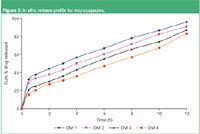
Figure 3
Drug–excipient compatibility study
From the overlay FTIR spectra, we observed no changes of main peaks in the IR spectra of the mixture of drug and polymers, which prove that there were no physical or chemical interactions between drug and polymers. Furthermore, the spectra obtained from the formulation suggest that drug completely bound with the polymer to form the microcapsules. The spectra obtained from the drug and drug–polymer physical mixture suggest that both drug and polymer showed a peak at around the requisite wave number, thereby suggesting that there was no reaction between the drug and the excipients.
Formaldehyde treatment of hard gelatin capsule
Formaldehyde treatment was used to modify the solubility of the hard gelatin capsules. The solubility test was conducted for normal capsules and formaldehydetreated capsules for 24 h. For the normal capsules, both cap and body dissolved within 15 min whereas, with the formaldehydetreated capsules, only the cap dissolved within 15 min, while the capsule body remained intact for about 24 h. This insolubility indicates suitability for colon targeting.
Evaluation of Pulsincap dosage
On the basis of drug content, particle size morphology, in vitro release and release kinetics, formulation DM3 was the better formulation for designing a pulsatile device. The results obtained for all 15 formulations (F1–F15) are shown in Figure 4. The in vitro release profile was comparable for formulations F1–F3 (a), F4–F6 (b) and F7–F9 (c), F10–F12 (d), F13–F15 (e), which contains NaCMC, GG, HPMCK4M, NaAlg and HPCH, respectively as hydrogel plugs at different proportions (i.e., 10, 15 and 20%).
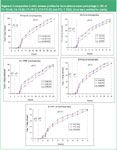
Figure 4
During the dissolution studies, the outer coat, which was made by CAP for all batches remained intact for 2 h in pH 1.2 and dissolved in intestinal pH, leaving the soluble cap of the capsule. The exposed polymer plug was then absorbed by the surrounding fluid, swelled and released the drug through the swollen matrix. After complete wetting of the plug, it formed a soft mass, which was easily ejected out of the capsule body; releasing the acrycoat microcapsules into SCF. With regard to the 10 and 15% hydrogel plug proportions, the polymer concentration was sufficient to retard the drug release in small intestinal fluid and the plug ejected out in colonic fluid, releasing the entire drug in colonic pH, in a controlled manner. However, with 20% hydrogel plug proportions, a decrease in the expelling power of plug was observed, which might be the result of inadequate wetting of the polymer.
The order of sustaining capacity of the polymers — GG HPMC>NaAlg NaCMC>HPC — was found on the basis of the tendency to produce a soft swollen matrix and time required to eject from the capsule body. The release of drug from the modified pulsatile capsule was proportional to the concentration of the polymer.

Creativ Studio Heinemann/Getty Images
Conclusion
Pulsatile drug release during a 24h period, consistent with the requirements for chronopharmaceutical drug delivery, was achieved from insoluble gelatin capsules, in which microencapsulated DS was sealed by a hydrogel plug (guar gum, hydroxypropylmethylcellulose, sodium alginate, sodium carboxymethylcellulose). This modified Pulsincap dosage form could be beneficial to the chronotherapy of RA as it has demonstrated programmable, time and pHdependent, sitespecific drug release, and offers an effective controlledrelease alternative to traditional dosage forms that have been met with poor patient compliance.
Dr Gayatri C.Patel is Assistant Professor at the Department of Pharmaceutics Maliba Pharmacy College Gopal Vidyanagar, Bardoli-Mahuva Road, Surat-394350, Gujarat (India). Tel. +91 2625 255144,255882 Fax +91 2625 255882 gayatripatel26@gmail.com
Dr Madhabhai M. Patel is Principal and Head of Department of Pharmaceutics and Pharmaceutical Technology at Kalol Institute of Pharmacy (India).
References
1. W.J. Elliott, Postgrad. Med., 110(2), 119–129 (2001).
2. C.B. Subal, Pharmabiz, August 2005.
3. A.J. Swannell, Br. J. Clin. Pract.,38, 16–19 (1983).
4. R. Kinget et al., J. Drug Target., 6(2), 129–149 (1998).
5. S. Sarasija and A. Hota, Indian J. Pharm. Sci., 62, 1–8 (2000).
6. C. Boissier, H. Decousus and B. Perpoint, Annual Review of Chronopharmacology,7(12), 289–292 (1990).
7. M. Sripathy, M.S. Srinath and K.L.K. Paranjothy, Eastern Pharmacist, 42(498), 97–98 (1999).
8. C.M. Adeyene and P.K. Li, "Diclofenac sodium," in K. Florey, Ed, Analytical profiles of drug substances, Volume 19 (Academic Press, New York, NY, USA, 1990) pp 123–144.
9. M. Alfred, J. Swarbrick and A. Cammarata, Physical Pharmacy, 4th Edition (B. I. Warerly Pvt.Ltd, New Delhi, India, 1999) p 355.
10. L. Lachman, A. Lieberman and J.L. Kinig, The Theory and Practice of Industrial Pharmacy, 4th Edition (Varghese Publishing House, Bombay, India, 1998) pp 67–68.
11. USP 23–NF 18 (USP Convention Inc., Rockville, MD, USA), p 940.
12. H.H. Willard et al., Instrumental Methods of Analysis, 6th Edition (CBS Publishers and Distributors, Delhi, India, 1986) pp 177–216.
13. X. Chen, S.Z. Jun and M.O. Yun, Drug Dev. Ind. Pharm., 31(2), 127–134 (2005).
14. C. Gang et al., World J. Gestroenterol., 10(12), 1769–1774 (2004)
15. R. Morta, L. Jose and J. Vila. J. Contr. Rel., 55(1), 67–77 (1998).
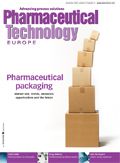
Drug Solutions Podcast: A Closer Look at mRNA in Oncology and Vaccines
April 30th 2024In this episode fo the Drug Solutions Podcast, etherna’s vice-president of Technology and Innovation, Stefaan De Koker, discusses the merits and challenges of using mRNA as the foundation for therapeutics in oncology as well as for vaccines.
Drug Solutions Podcast: Applying Appropriate Analytics to Drug Development
March 26th 2024In this episode of the Drug Solutions Podcast, Jan Bekker, Vice President of Business Development, Commercial and Technical Operations at BioCina, discusses the latest analytical tools and their applications in the drug development market.
INTERPHEX 2025: Use of Walk-In Chambers for Bio/Pharma Development and Manufacturing
April 2nd 2025Sitting down with the PharmTech Group at INTERPHEX 2025, Christopher Murphy, director of Global Business Development and Service Customer Support at Environmental Specialties, discusses the design and critical role of walk-in chambers in the bio/pharmaceutical industry.